
Perkins Cemetery, image courtesy of Rachael Finch.
Cemeteries, like historic buildings, homes, and landscapes, connect the past with our future. With beautiful architecture, cultural sites, and landscapes across the country, it can be easy to forget about some of our lesser known – or acknowledged – historic places, like cemeteries. Regardless, these places are important to the everyday life of American history and culture and more significantly, they are present in nearly every community.
Last fall, the Heritage Foundation met with the current owners of the Perkins cemetery at the property and most recently, provided a cemetery preservation plan which will guide the next steps for preserving the cemetery and conserving many of the fragile headstones. The Perkins cemetery, like many cemeteries in Williamson County, tells a multi-layered, multi-cultural story.
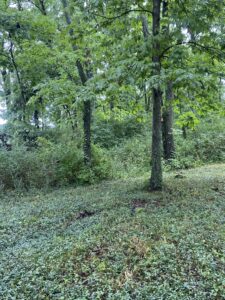
The Perkins Cemetery, located today in the Two Rivers rural subdivision, is believed to be a large graveyard containing 19th and 20thcentury burials. Particularly noteworthy is the large growth of ground covering in the summertime, making it difficult to fully document until late fall/early winter 2022 and 2023. Image courtesy of the Heritage Foundation of Williamson County.
The Perkins cemetery, located in a rural residential neighborhood today, was once a part of a large multi-plantation complex that included Meeting of the Waters and Montpier. Thomas Hardin Perkins, an American Revolutionary War veteran, immigrated to Williamson County, Tennessee, from Virginia in the late 1790s, purchasing over 600 acres of land from James Robertson along the riverbanks of where the Little Harpeth and Big Harpeth Rivers meet. Prior to their death, he and his wife Mary amassed additional lands, 159 enslaved persons, and built a fine mansion known as Meeting of the Waters (1800-1809), located on today’s modern-day road, Del Rio Pike.
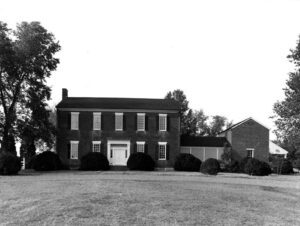
Meeting of the Waters, during its restoration. Today, it is privately owned. Image courtesy of the Williamson County Historical Society.
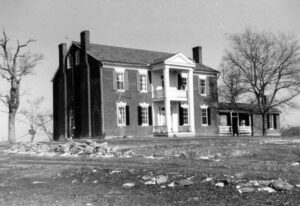
Montpier, ca. 1980s. Today, it is privately owned. Image courtesy of the Williamson County Historical Society.
Thomas Hardin Perkins’ daughter Mary married her first cousin Nicholas “Bigbee” Perkins, and together, raised a large family, building their own mansion on family lands, creating a large plantation known as Montpier. From ongoing research as well as local oral tradition, it is believed many of the Perkins’ enslaved are also buried in unmarked graves. Deeper investigation also revealed several early 20th century tombstones not connected to the Perkins family, rather, tenant farmers who worked and lived on the land.
So, why do local cemeteries matter? The answer is simple. Saving cemeteries is the preservation of our collective history. Cemeteries are places for reflection and commemoration. They are of great interest to historic and genealogical researchers. Cemeteries help us build a sense of community and placemaking. When a cemetery is desecrated, threatened by uncontrolled development or decay, descendants and citizens often feel violated and powerless. Many cemeteries face significant threats including development and deterioration due to natural environmental factors. While most damage is created by human hands, sometimes the damage is created by those who attempt to preserve them. While commercial development, agricultural land-clearing, and desecration are the best-known threats, improper cleaning and layman restoration techniques are just as destructive.
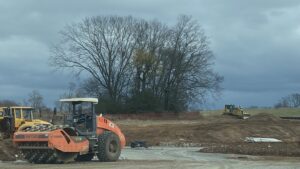
The Pointer Cemetery, once a part of the Alexander farm and located in the cluster of trees, is now surrounded by development in progress for the newest Spring Hill project, June Lake. Image courtesy of the Heritage Foundation of Williamson County.
As preservationists, public historians, and cemetery preservation advocates, we all sense the urgency to reclaim and preserve our history. These places matter and merit our respect, protection, and offer an opportunity to preserve and reflect the voices once marginalized, left out of the historical narrative, the death of any living descendants, or simply lost to time and widespread development. Telling their stories through the preservation of these sacred spaces is vital to impart an authentic interpretation of all Williamson County’s local communities, their history, and our collective past in American history.
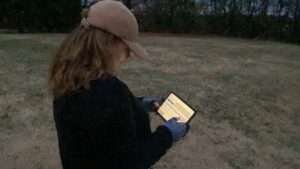
Rachael Finch, preservationist and cultural resource management expert, uses GIS technology to map all historic cemeteries in Williamson County for the Heritage Foundation’s Williamson County Historic and Cultural Resource Survey. Image courtesy of Rachael Finch.
Preservation of our cemeteries is critical, and we cannot do it alone. Please join us as we advocate for saving our cemeteries. The Heritage Foundation of Williamson County is a fifty-six-year-old organization dedicated to preserving the places and sharing all stories associated with the county’s history and culture. Through its continued stewardship, the Heritage Foundation offers preservation services, including cemetery preservation plans, property histories, condition assessments of historic properties, and much more. If anyone is interested in learning more about how to preserve, rehabilitate, or simply learn more about the history of their property or has a cemetery on their property, please reach out to Chief Officer of Engagement Tyrus Sturgis at tsturgis@williamsonheritage.org. If you would like to financially support the Heritage Foundation’s preservation and education initiatives as we document our historic resources, please reach out to Chief Advancement Officer, Grant Martin at gmartin@williamsonheritage.org. The Heritage Foundation team would enjoy the opportunity to visit so we may collaborate on sharing stories and saving our cemeteries in Williamson County.
Blog by Rachael Finch, Historic Preservationist and Cultural Resources Consultant